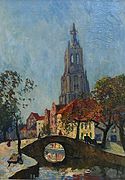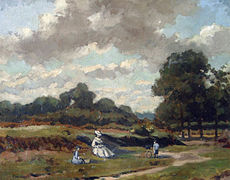Charles Dankmeijer
Charles Dankmeijer | |
|---|---|
 | |
| Born | 8 April 1861 |
| Died | 11 March 1923 (aged 61) |
| Nationality | Dutch |
| Occupation | Painter |
Carel Bernardus Dankmeijer, known as Charles (1861-1923) was a Dutch painter; best known for his colorful cityscapes and river scenes.
Biography
He took his first drawing lessons at the Felix Meritis Society of Amsterdam. In 1881, he went to Antwerp, where he studied at the Royal Academy of Fine Arts with Charles Verlat and won the "Prix d'Excellence". From 1882 to 1886, he was enrolled at the Rijksakademie. His professors there were August Allebé and Barend Wijnveld. He then joined the artists' colony in Laren, and came under the influence of Anton Mauve.[1]
After Mauve's death, he returned to Amsterdam and was married. For many years after that, he moved frequently; living in The Hague, Loosduinen, Zaandam, Renkum (where he worked with Théophile de Bock), Oosterbeek, Leiden and, finally, Scheveningen. This was interspersed with travels to France and Italy. In 1900, he won a medal at the Exposition Universelle.[1]
A slightly eccentric man, it was said that you could tell what colors were on his palette from the stains on his jacket. When inspired, he often walked through town so lost in thought that he would not even recognize his friends.[2]
Gallery
-
View of Alkmaar
-
View of Delft
-
View of Goedereede
-
A Canal in Hoorn
-
Picnic
References
- ^ a b Brief biography @ the De Valk Lexicon kunstenaars Laren-Blaricum.
- ^ Johan Wesselink: Schilders van de Veluwezoom, J.G. Strengholt's Uitgeversmaatschappij, Amsterdam, 1943, reprinted 1980 ISBN 90-623-5031-3
Further reading
- Maarten Bol: Charles Dankmeijer 1861-1923. een gedreven, kleurrijk schilder, Renkum 2002. ISBN 90-803264-3-7
External links





